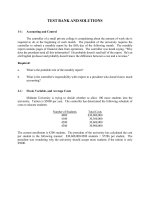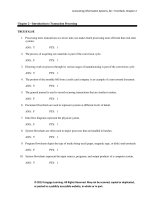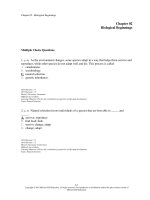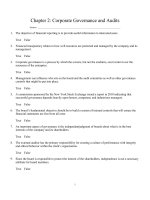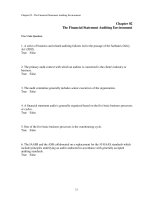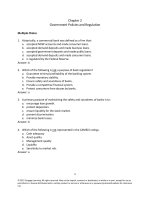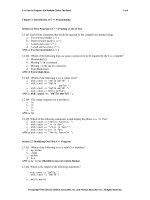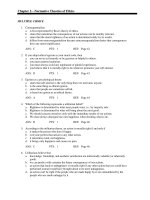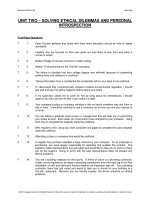Microeconomics 8th edition pindyck test bank
Bạn đang xem bản rút gọn của tài liệu. Xem và tải ngay bản đầy đủ của tài liệu tại đây (465.14 KB, 46 trang )
Microeconomics, 8e (Pindyck/Rubinfeld)
Chapter 2 The Basics of Supply and Demand
2.1 Supply and Demand
1) Which of the following is NOT an application of supply and demand analysis?
A) Understanding changing world economic conditions and their effects on prices
B) Evaluating the effects of government price controls on the agricultural industry
C) Determining how taxes affect aggregate consumption spending patterns
D) all of the above
E) none of the above
Answer: E
Diff: 1
Section: 2.1
2) A supply curve reveals:
A) the quantity of output consumers are willing to purchase at each possible market price.
B) the difference between quantity demanded and quantity supplied at each price.
C) the maximum level of output an industry can produce, regardless of price.
D) the quantity of output that producers are willing to produce and sell at each possible market price.
Answer: D
Diff: 1
Section: 2.1
3) Plastic and steel are substitutes in the production of body panels for certain automobiles. If the price
of plastic increases, with other things remaining the same, we would expect:
A) the price of steel to fall.
B) the demand curve for steel to shift to the right.
C) the demand curve for plastic to shift to the left.
D) nothing to happen to steel because it is only a substitute for plastic.
E) the demand curve for steel to shift to the left.
Answer: B
Diff: 1
Section: 2.1
4) Coffee and cream:
A) are both luxury goods.
B) are complements.
C) are both more inelastic in demand in the long run than in the short run.
D) have a positive cross price elasticity of demand.
Answer: B
Diff: 1
Section: 2.1
1
Copyright © 2013 Pearson Education, Inc.
5) Which of the following would shift the demand curve for new textbooks to the right?
A) A fall in the price of paper used in publishing texts
B) A fall in the price of equivalent used textbooks
C) An increase in the number of students attending college
D) A fall in the price of new textbooks.
Answer: C
Diff: 1
Section: 2.1
6) When an industry's raw material costs increase, other things remaining the same,
A) the supply curve shifts to the left.
B) the supply curve shifts to the right.
C) output increases regardless of the market price and the supply curve shifts upward.
D) output decreases and the market price also decreases.
Answer: A
Diff: 1
Section: 2.1
7) Sugar can be refined from sugar beets. When the price of those beets falls,
A) the demand curve for sugar would shift right.
B) the demand curve for sugar would shift left.
C) the supply curve for sugar would shift right.
D) the supply curve for sugar would shift left.
Answer: C
Diff: 1
Section: 2.1
8) Assume that steak and potatoes are complements. When the price of steak goes up, the demand curve
for potatoes:
A) shifts to the left.
B) shifts to the right.
C) remains constant.
D) shifts to the right initially and then returns to its original position.
Answer: A
Diff: 1
Section: 2.1
9) Which of the following events will cause a leftward shift in the supply curve of gasoline?
A) A decrease in the price of gasoline
B) An increase in the wage rate of refinery workers
C) Decrease in the price of crude oil
D) An improvement in oil refining technology
E) all of the above
Answer: B
Diff: 1
Section: 2.1
2
Copyright © 2013 Pearson Education, Inc.
10) Which of the following will NOT cause a shift in the supply of gasoline?
A) An increase in the wage rate of refinery workers
B) A decrease in the price of gasoline
C) An improvement in oil refining technology
D) A decrease in the price of crude oil
Answer: B
Diff: 1
Section: 2.1
11) Which of the following would cause a shift to the right of the supply curve for gasoline?
I. A large increase in the price of public transportation.
II. A large decrease in the price of automobiles.
III. A large reduction in the costs of producing gasoline.
A) I only
B) II only
C) III only
D) II and III only
Answer: C
Diff: 2
Section: 2.1
12) You are analyzing the demand for good X. Which of the following will result in a shift to the right
of the demand curve for X?
A) A decrease in the price of X
B) An increase in the price of a good that is a complement to good X
C) An increase in the price of a good that is a substitute for X
D) all of the above
Answer: C
Diff: 1
Section: 2.1
13) The price of good A goes up. As a result, the demand for good B shifts to the left. From this we can
infer that:
A) good A is used to produce good B.
B) good B is used to produce good A.
C) goods A and B are substitutes.
D) goods A and B are complements.
E) none of the above
Answer: D
Diff: 2
Section: 2.1
3
Copyright © 2013 Pearson Education, Inc.
14) Which of the following will cause the demand curve for Beatles' compact discs to shift to the right?
A) An increase in the price of the discs
B) A decrease in consumers' incomes
C) An increase in the price of Phil Collins' latest compact disc (a substitute)
D) all of the above
E) none of the above
Answer: C
Diff: 1
Section: 2.1
15) Which of the following will NOT cause a rightward shift in the demand curve for beer?
A) A change in the price of beer
B) A health study indicating positive health benefits of moderate beer consumption
C) An increase in the price of French wine (a substitute)
D) A decrease in the price of potato chips (a complement)
E) none of the above
Answer: A
Diff: 1
Section: 2.1
16) Which of the following would cause a rightward shift in the demand curve for gasoline?
I. A large increase in the price of public transportation.
II. A large decrease in the price of automobiles.
III. A large reduction in the costs of producing gasoline.
A) I only
B) II only
C) I and II only
D) II and III only
E) I, II, and III
Answer: C
Diff: 2
Section: 2.1
17) Suppose biochemists discover an enzyme that can double the amount of ethanol that may be derived
from a given amount of biomass. Based on this technological development, we expect the:
A) supply curve for ethanol to shift leftward.
B) supply curve for ethanol to shift rightward.
C) demand curve for ethanol to shift leftward.
D) demand curve for ethanol to shift rightward.
Answer: B
Diff: 1
Section: 2.1
4
Copyright © 2013 Pearson Education, Inc.
18) The discussion of Figure 2.2 in the text indicates that quantity demanded for most goods tends to
increase as income rises. However, the quantity of bananas demanded in the U.S. tends to decrease as
income rises. Under this condition, we expect that an increase in consumer income shifts the demand
curve for bananas:
A) rightward
B) no shift.
C) leftward.
D) upward.
Answer: C
Diff: 1
Section: 2.1
19) Due to the recent increase in the price of natural gas, the quantity of coal demanded by electric
power generation plants has increased. Based on this information, coal and natural gas are:
A) complements.
B) substitutes.
C) independent goods.
D) none of the above
Answer: B
Diff: 1
Section: 2.1
20) To protect the cod fishery off the northeast coast of the U.S., the federal government may limit the
amount of fish that each boat can catch in the fishery. The result of this public policy is to:
A) shift the cod demand curve to the left.
B) shift the cod demand curve to the right.
C) shift the cod supply curve to the right.
D) shift the cod supply curve to the left.
Answer: D
Diff: 1
Section: 2.1
21) The battery packs used in electric and hybrid automobiles are one of the largest cost components for
manufacturing these cars. As the price of these batteries decline, we expect that the:
A) supply curve for electric and hybrid autos will shift rightward.
B) supply curve for electric and hybrid autos will shift leftward.
C) demand curve for electric and hybrid autos will shift rightward.
D) demand curve for electric and hybrid autos will shift leftward.
Answer: A
Diff: 1
Section: 2.1
5
Copyright © 2013 Pearson Education, Inc.
22) Rare earth metals are used to manufacture some important electronic components in popular
products like cell phones. These metals are not really rare, but they are expensive to extract from the
ground. What happens to the market for the rare earth metals if these extraction costs increase?
A) Demand curve shifts leftward
B) Demand curve shifts rightward
C) Supply curve shifts leftward
D) Supply curve shifts rightward
Answer: C
Diff: 1
Section: 2.1
2.2 The Market Mechanism
1) When the current price is above the market-clearing level we would expect:
A) quantity demanded to exceed quantity supplied.
B) quantity supplied to exceed quantity demanded.
C) a shortage.
D) greater production to occur during the next period.
Answer: B
Diff: 1
Section: 2.2
2) Assume that the current market price is below the market clearing level. We would expect:
A) a surplus to accumulate.
B) downward pressure on the current market price.
C) upward pressure on the current market price.
D) lower production during the next time period.
Answer: C
Diff: 1
Section: 2.2
3) As long as the actual market price exceeds the equilibrium market price, there will be:
A) downward pressure on the market price.
B) upward pressure on the market price.
C) no purchases made.
D) Both A and C are correct.
E) Both B and C are correct.
Answer: A
Diff: 1
Section: 2.2
4) If the actual price were below the equilibrium price in the market for bread, a:
A) surplus would develop that cannot be eliminated over time.
B) shortage would develop, which market forces would eliminate over time.
C) surplus would develop, which market forces would eliminate over time.
D) shortage would develop, which market forces would tend to exacerbate.
Answer: B
Diff: 1
Section: 2.2
6
Copyright © 2013 Pearson Education, Inc.
5) Suppose the quantity of nursing services demanded exceeds the quantity of nursing services supplied.
The nursing wage rate will:
A) decrease.
B) increase.
C) not change.
D) none of the above
Answer: B
Diff: 1
Section: 2.2
Scenario 2.1:
The demand for books is:
The supply of books is:
Qd = 120 - P
Qs = 5P
6) Refer to Scenario 2.1. What is the equilibrium price of books?
A) 5
B) 10
C) 15
D) 20
E) none of the above
Answer: D
Diff: 1
Section: 2.2
7) Refer to Scenario 2.1. What is the equilibrium quantity of books sold?
A) 25
B) 50
C) 75
D) 100
E) none of the above
Answer: D
Diff: 1
Section: 2.2
8) Refer to Scenario 2.1. If P = $15, which of the following is true?
A) There is a surplus equal to 30.
B) There is a shortage equal to 30.
C) There is a surplus, but it is impossible to determine how large.
D) There is a shortage, but it is impossible to determine how large.
Answer: B
Diff: 2
Section: 2.2
7
Copyright © 2013 Pearson Education, Inc.
9) Refer to Scenario 2.1. If P = $15, which of the following is true?
A) Quantity supplied is greater than quantity demanded.
B) Quantity supplied is less than quantity demanded.
C) Quantity supplied equals quantity demanded.
D) There is a surplus.
Answer: B
Diff: 1
Section: 2.2
10) Refer to Scenario 2.1. If P = $25, which of the following is true?
A) There is a surplus equal to 30.
B) There is a shortage equal to 30.
C) There is a shortage, but it is impossible to determine how large.
D) There is a surplus, but it is impossible to determine how large.
Answer: A
Diff: 2
Section: 2.2
11) Refer to Scenario 2.1. If P = $25, which of the following is true?
A) Quantity supplied is greater than quantity demanded.
B) Quantity supplied is less than quantity demanded.
C) Quantity supplied equals quantity demanded.
D) There is a shortage.
Answer: A
Diff: 1
Section: 2.2
12) Suppose the equilibrium price of milk is $3 per gallon but the federal government sets the market
price at $4 per gallon. The market mechanism will force the milk price back down to $3 per gallon
unless the government:
A) rations the excess demand for milk among consumers.
B) buys the excess supply of milk and removes it from the market.
C) Both A and B are plausible actions.
D) The government cannot maintain the price above the equilibrium level.
Answer: B
Diff: 2
Section: 2.2
13) The current market price for good X is below the equilibrium price, and then the demand curve for
X shifts rightward. What is the likely outcome of the demand shift?
A) The surplus increases.
B) The surplus decreases.
C) The shortage increases.
D) The shortage decreases.
Answer: C
Diff: 1
Section: 2.2
8
Copyright © 2013 Pearson Education, Inc.
14) Suppose there is currently a surplus of wheat on the world market. The problem of excess supply
may be removed from the market by:
A) lowering the market price.
B) shifting the supply curve leftward.
C) shifting the demand curve leftward.
D) Both A and B are plausible actions.
Answer: D
Diff: 2
Section: 2.2
15) Which of the following statements is NOT true?
A) Unemployment in the US economy represents an excess demand for labor.
B) A surplus may be reduced by shifting the demand curve rightward.
C) A surplus may be reduced by shifting both the supply and demand curves.
D) A shortage may be reduced by shifting the supply rightward.
Answer: A
Diff: 2
Section: 2.2
16) Suppose Congress passes a law that states the price of gasoline may not exceed $6 per gallon (but
may be lower). If the current price of gasoline is less than $6, what impact does this law have on the
current price and quantity of gasoline in the US market?
A) There is a shortage of gasoline
B) There is a surplus of gasoline
C) Quantity supplied currently equals quantity demanded, but a surplus is possible at prices above $6
D) The law currently has no impact, and the market clears at the equilibrium price
Answer: D
Diff: 2
Section: 2.2
9
Copyright © 2013 Pearson Education, Inc.
17) The inverse demand curve for product X is given by:
PX = 25 - 0.005Q + 0.15PY,
where PX represents price in dollars per unit, Q represents rate of sales in pounds per week, and PY
represents selling price of another product Y in dollars per unit. The inverse supply curve of product X
is given by: PX = 5 + 0.004Q.
a. Determine the equilibrium price and sales of X. Let PY = $10.
b. Determine whether X and Y are substitutes or complements.
Answer:
a.
Equate supply to demand to calculate Q.
25 - 0.005Q + 0.15(10) = 5 + 0.004Q
21.5 = 0.009Q
Q = 2,388.9 units per week
At Q = 2,388.9, P = 25 - .005(2,388.9) + 0.15(10)
= $14.56 per unit.
b.
Since we can solve for quantity demanded as a function of prices,
Q=
we see that there is a direct, positive relationship between Q and PY. An increase in the price of good Y
generates an increase in the quantity demanded for good X at any value of PX, which implies that goods
Y and X are substitutes.
Diff: 2
Section: 2.2
10
Copyright © 2013 Pearson Education, Inc.
18) The daily demand for hotel rooms on Manhattan Island in New York is given by the equation
QD = 250,000 - 375P. The daily supply of hotel rooms on Manhattan Island is given by the equation
QS = 15,000 + 212.5P. Diagram these demand and supply curves in price and quantity space.
What is the equilibrium price and quantity of hotel rooms on Manhattan Island?
Answer: The equilibrium price can be found by equating quantity demanded and quantity supplied
(graphically, this is where the Demand and Supply curves intersect). The solution for the equilibrium
price may be derived from QD = 250,000 - 375P = 15,000 + 212.5P = QS . We can then solve for
equilibrium price as P =
= 400. At a price of $400, quantity supplied and quantity demanded
are 100,000.
Diff: 1
Section: 2.2
2.3 Changes in Market Equilibrium
1) Which of the following would cause an unambiguous decrease in the real price of DVD players?
A) A shift to the right in the supply curve for DVD players and a shift to the right in the demand curve
for DVD players.
B) A shift to the right in the supply curve for DVD players and a shift to the left in the demand curve for
DVD players.
C) A shift to the left in the supply curve for DVD players and a shift to the right in the demand curve for
DVD players.
D) A shift to the left in the supply curve for DVD players and a shift to the left in the demand curve for
DVD players.
Answer: B
Diff: 2
Section: 2.3
11
Copyright © 2013 Pearson Education, Inc.
2) From 1970 to 2010, the real price of a college education increased, and total enrollment increased.
Which of the following could have caused this increase in price and enrollment?
A) A shift to the right in the supply curve for college education and a shift to the left in the demand
curve for college education.
B) A shift to the left in the supply curve for college education and a shift to the right in the demand
curve for college education.
C) A shift to the left in the supply curve for college education and a shift to the left in the demand curve
for college education.
D) none of the above
Answer: B
Diff: 3
Section: 2.3
3) From 1970 to 2010, the real price of eggs decreased. Which of the following would cause an
unambiguous decrease in the real price of eggs?
A) A shift to the right in the supply curve for eggs and a shift to the right in the demand curve for eggs.
B) A shift to the right in the supply curve for eggs and a shift to the left in the demand curve for eggs.
C) A shift to the left in the supply curve for eggs and a shift to the right in the demand curve for eggs.
D) A shift to the left in the supply curve for eggs and a shift to the left in the demand curve for eggs.
Answer: B
Diff: 2
Section: 2.3
4) From 1970 to 2010, the real price of eggs decreased and the total annual consumption of eggs
decreased. Which of the following would cause an unambiguous decrease in the real price of eggs and
an unambiguous decrease in the quantity of eggs consumed?
A) A shift to the right in the supply curve for eggs and a shift to the right in the demand curve for eggs.
B) A shift to the left in the supply curve for eggs and a shift to the right in the demand curve for eggs.
C) A shift to the left in the supply curve for eggs and a shift to the left in the demand curve for eggs.
D) none of the above
Answer: D
Diff: 3
Section: 2.3
5) We observe that both the price of and quantity sold of golf balls are rising over time. This is due to:
A) continual improvements in the technology used to produce golf balls.
B) increases in the price of golf clubs over time.
C) decreases in membership fees for country clubs with golf facilities.
D) more stringent professional requirements on the quality of golf balls requiring producers to use more
expensive raw materials.
Answer: C
Diff: 3
Section: 2.3
12
Copyright © 2013 Pearson Education, Inc.
6) Which of the following will cause the price of beer to rise?
A) A shift to the right in the demand curve for beer
B) A shift to the left in the supply curve of beer
C) both A and B
D) none of the above
Answer: C
Diff: 1
Section: 2.3
Scenario 2.2:
In 1992, the Occupational Safety and Health Authority passed the Bloodborne Pathogens Standard
(BBP), which regulates dental office procedures. This regulation is designed to minimize the
transmission of infectious disease from patient to dental worker. The effect of this regulation was both
to increase the cost of providing dental care and to ease the fear of going to the dentist as the risk of
contracting an infectious disease.
7) Refer to Scenario 2.2. What is the effect of the BBP on the market for dental care?
A) Only the supply curve shifts.
B) Only the demand curve shifts.
C) Both the demand and supply curves shift.
D) Neither the demand nor supply curve shifts.
Answer: C
Diff: 1
Section: 2.3
8) Refer to Scenario 2.2. What is the effect of the BBP on the market for dental care?
A) Both supply and demand shift to the right.
B) Both supply and demand shift to the left.
C) Supply shifts to the right, and demand shifts to the left.
D) Supply shifts to the left, and demand shifts to the right.
E) none of the above
Answer: D
Diff: 1
Section: 2.3
9) Refer to Scenario 2.2. What is the effect of the BBP on the equilibrium price of dental care?
A) It unambiguously increases.
B) It unambiguously decreases.
C) It increases only if supply shifts more than demand.
D) It increases only if demand shifts more than supply.
Answer: A
Diff: 2
Section: 2.3
13
Copyright © 2013 Pearson Education, Inc.
10) Refer to Scenario 2.2. Under what circumstances will the equilibrium level of output of dental care
remain the same?
A) If supply shifts more than demand.
B) If demand shifts more than supply.
C) If both demand and supply shift by the same magnitude.
D) If supply and demand shift in the same direction.
Answer: C
Diff: 2
Section: 2.3
11) Refer to Scenario 2.2. Under what circumstances will the equilibrium level of output of dental care
increase?
A) If supply shifts more than demand.
B) If demand shifts more than supply.
C) If both demand and supply shift by the same magnitude.
D) If supply and demand both decrease.
Answer: B
Diff: 2
Section: 2.3
12) After the September 11, 2001 attacks on the World Trade Center, the supply of downtown office
space in Manhattan was dramatically reduced. Forecasters predicted that the equilibrium price would
rise, but in fact the price fell. What are some factors that could explain the fall in the equilibrium price,
which the forecasters failed to take into account?
A) Demand for office space fell due to quality-of-life concerns.
B) The economic slowdown caused demand for office space to fall.
C) both A and B
D) none of the above
Answer: C
Diff: 1
Section: 2.3
13) The effect of the September 11 attacks on the World Trade Center on the market for office space in
downtown Manhattan was that both the equilibrium price and the equilibrium quantity fell. What is the
most likely explanation for this?
A) Supply and demand both shifted left, and the magnitude of the demand shift was greater.
B) Supply and demand both shifted left, and the magnitude of the supply shift was greater.
C) Supply shifted left, demand shifted right, and the magnitude of the demand shift was greater.
D) Supply shifted left, demand shifted right, and the magnitude of the supply shift was greater.
Answer: A
Diff: 2
Section: 2.3
14
Copyright © 2013 Pearson Education, Inc.
14) In recent years, the world demand curve for copper shifted rightward due to continued economic
growth in China and other emerging economies. Also, the costs of extracting the copper increased due
to higher energy prices. As a result, we observed:
A) higher equilibrium copper prices and unambiguously lower quantities.
B) higher equilibrium copper prices and unambiguously higher quantities.
C) higher equilibrium copper prices and either higher or lower quantities.
D) lower equilibrium copper prices and either higher or lower quantities.
Answer: C
Diff: 2
Section: 2.3
15) Suppose the supply of textbooks is upward sloping and shifts leftward due to higher ink and paper
costs. Which of the following events would leave the equilibrium price of textbooks at the same level
observed before the supply shift?
A) Demand is perfectly elastic (horizontal).
B) Demand is downward sloping and shifts leftward.
C) all of the above
D) none of the above
Answer: C
Diff: 1
Section: 2.3
16) If we plot the quantity of aluminum ore mined per year on the horizontal axis and the real annual
price of aluminum ore on the vertical axis, we find that the path of price-quantity combinations
generally indicates lower real prices and higher quantities over time. Which of the following statements
is a plausible explanation for this observed outcome?
A) Aluminum supply shifted leftward faster than the aluminum demand curve shifted rightward.
B) Aluminum supply shifted rightward faster than the aluminum demand curve shifted rightward.
C) Aluminum supply shifted rightward and aluminum demand remained constant.
D) both A and B above
E) both B and C above
Answer: E
Diff: 2
Section: 2.3
17) Over the next few years, several newly constructed office blocks will become available at the World
Trade Center site. As well, economists expect the New York economy will continue to exhibit modest
growth. What is the expected outcome for the office space market in downtown Manhattan?
A) Unambiguously higher equilibrium rental rates and quantity
B) Unambiguously lower equilibrium rental rates and quantity
C) Unambiguously higher rental rates, and equilibrium quantity could be higher or lower
D) Unambiguously higher equilibrium quantity, and equilibrium rental rates could be higher or lower
Answer: D
Diff: 1
Section: 2.3
15
Copyright © 2013 Pearson Education, Inc.
18) By 2020, automobile market analysts expect that the demand for electric autos will increase as
buyers become more familiar with the technology. However, the costs of producing electric autos may
increase because of higher costs for inputs (e.g., rare earth elements), or they may decrease as the
manufacturers learn better assembly methods (i.e., learning by doing). What is the expected impact of
these changes on the equilibrium price and quantity for electric autos?
A) Unambiguously higher equilibrium price and quantity
B) Unambiguously higher price, and equilibrium quantity may be higher or lower
C) Unambiguously higher quantity, and equilibrium price may be higher or lower
D) We cannot form any unambiguous expectations for either price or quantity
Answer: D
Diff: 2
Section: 2.3
19) Suppose a new discovery in computer manufacturing has just made computer production cheaper.
Also, the popularity and usefulness of computers continues to grow. Use Supply and Demand analysis
to predict how these shocks will affect equilibrium price and quantity of computers. Is there enough
information to determine if market prices will rise or fall? Why?
Answer: The increase in demand due to the usefulness of computers will shift the demand curve to the
right. This effect alone on the market will influence the market price and quantity to rise. This is shown
above by a movement from the original demand curve D0 to a new demand curve such as D1' or D1''.
The reduction in the cost of producing computers will result in an increase in supply (a rightward shift of
the supply curve). This effect alone on the market will influence the price of computers to fall while the
quantity will increase. Note that the supply and demand effects on price work in opposite directions. If
the supply effect dominates the demand effect, the equilibrium prices will fall. This is exhibited by the
increase in demand to only D1'. On this demand curve, the net effect is for prices to fall from P0 to P1'.
On the other hand if the demand effect dominates, equilibrium prices will rise. This is exhibited by the
increase in demand to D1''. On this demand curve, the net effect is for prices to rise from P0 to P1''. As
we don't know given the current information which effect dominates, we can't perfectly predict the
change in price. The change in quantity is unambiguously increased.
Diff: 2
Section: 2.3
16
Copyright © 2013 Pearson Education, Inc.
20) Suppose that due to more stringent environmental regulation it becomes more expensive for steel
production firms to operate. Also, recent technological advances in plastics has reduced the demand for
steel products. Use Supply and Demand analysis to predict how these shocks will affect equilibrium
price and quantity of steel. Can we say with certainty that the market price for steel will fall? Why?
Answer: The increase in the cost of production of steel will shift the supply curve to the left. This effect
alone on the market will influence the market price to rise while the market quantity will fall. This is
shown above by a movement from the original supply curve S0 to a new supply curve such as S1. The
decrease in demand will cause the demand curve to shift to the left. This effect alone on the market will
influence the market price and quantity of steel to fall. Note that the supply and demand effects on price
work in opposite directions. If the supply effect dominates the demand effect, the equilibrium prices
will rise. This is exhibited by the decrease in demand to D1'. On this demand curve, the net effect is for
prices to rise from P0 to P1'. On the other hand if the demand effect dominates, the equilibrium price
will decline. This is exhibited by the decrease in demand to D1''.
On this demand curve, the net effect is for prices to fall from P0 to P1''. As we don't know given the
current information which effect dominates, we can't perfectly predict the change in price. The change
in equilibrium quantity is unambiguously decreased.
Diff: 2
Section: 2.3
17
Copyright © 2013 Pearson Education, Inc.
21) Historically, investors have considered gold commodities to be a good investment to preserve wealth
in times of inflation. If investors are no longer worried about inflation and gold demand decreases, what
do you expect will happen to gold prices? How would your answer change if you learn that a recent
gold mine discovery will increase the supply of gold?
Answer: The decrease in gold demand due to reduced fears of inflation will shift the demand curve to
the left. This is indicated above by a movement from D0 to D1. The effect on gold prices is negative.
If new gold discoveries increase the supply of gold, the supply curve will shift to the right. This effect
will also exert downward pressure on gold prices. This effect is diagrammed above as a movement from
S0 to S1. Since both effects cause gold prices to become lower, we can say unambiguously that gold
prices will decline.
Diff: 2
Section: 2.3
18
Copyright © 2013 Pearson Education, Inc.
22) The currency used by the Confederate States of America during its brief existence from 1861 to
1865 has become a collector's item today. The Confederate Currency supply is perfectly inelastic. As
the demand for the collectible increases and some of the old currency is destroyed or no longer of value
as a collectible, what happens to the market price?
Answer: The increase in demand for Confederate currency will result in a rightward shift of demand
from D0 to D1. This demand effect will put upward pressure on the price of Confederate currency.
As some of the collectibles deteriorate and become worthless, the supply curve shifts back to the left as
indicated above by the movement from S0 to S1. The supply effect places upward pressure on prices.
Both effects put upward pressure on prices, so we can say unambiguously that prices for Confederate
currency will rise.
Diff: 2
Section: 2.3
19
Copyright © 2013 Pearson Education, Inc.
23) Suppose the cable TV industry is currently unregulated. However, due to complaints from
consumers that the price of cable TV is too high, the legislature is considering placing a price ceiling on
cable TV below the current equilibrium price. Assuming the government does make this price ceiling
law, please construct a diagram that shows the impact of this law on the cable TV market, and please
briefly explain the effects on market prices and quantities with supply and demand analysis. Also, if the
cable TV company is worried about disgruntling customers, the company may introduce a different type
of programming that is cheaper for the company to provide yet is equally appealing to customers. What
would be the effects of this action?
Answer: Before implementation of the price ceiling, the equilibrium price and quantity is given by the
intersection of demand and supply. This is illustrated above as p0 and q0. A price ceiling below the
initial equilibrium price will cause a shortage. That is quantity demanded (qdc) at the price ceiling (pc)
exceeds quantity supplied (qsc). To avoid upsetting consumers, the company may provide a lower
quality cable TV subscription. This cheaper package would increase the supply of cable TV. The
supply curve will rightward. This action will move towards eliminating the cable TV shortage as the
quantity supplied of the modified package increases.
Diff: 2
Section: 2.3
20
Copyright © 2013 Pearson Education, Inc.
24) Suppose that the resale of tickets to professional football games is illegal in Missouri. Due to the
high demand for Chiefs (who play in Kansas City, Missouri) tickets there is a shortage of tickets at the
current ticket price. Given that the Chiefs will not raise the price at which they sell the tickets, what
would be the result of allowing tickets to be resold in a secondary market at whatever price the market
would support? If speculators entered the market and began buying tickets directly from the Chiefs in
hopes of reselling the tickets later, what would happen to the line outside of the ticket offices when the
tickets are initially sold?
Answer: Initially, there is a shortage due to the prohibition of resale of tickets above face value. That is
quantity demanded (qd0) exceeds quantity supplied (q) at the face value price (pfv). If resale of tickets
is allowed, the shortage will disappear as market forces bid the price of Chief tickets up to the price at
which quantity demanded and supplied are equal. If the Chiefs organization continues to sell tickets at
p0, speculators may begin purchasing the tickets directly in hopes of reselling the tickets on the
secondary market for higher prices. The influx of speculative demand will shift the demand curve to the
right. This implies that at face value, there is even a greater shortage for tickets, and the line outside the
ticket office will grow longer.
Diff: 3
Section: 2.3
2.4 Elasticities of Supply and Demand
1) The income elasticity of demand is the
A) absolute change in quantity demanded resulting from a one unit increase in income.
B) percent change in quantity demanded resulting from the absolute increase in income.
C) percent change in quantity demanded resulting from a one percent increase in income.
D) percent change in income resulting from a one percent increase in quantity demanded.
E) percent change in income resulting from a one percent increase in price.
Answer: C
Diff: 1
Section: 2.4
21
Copyright © 2013 Pearson Education, Inc.
2) The price elasticity of demand for a demand curve that has a zero slope is
A) zero.
B) one.
C) negative but approaches zero as consumption increases.
D) infinity.
Answer: D
Diff: 1
Section: 2.4
3) Elasticity measures
A) the slope of a demand curve.
B) the inverse of the slope of a demand curve.
C) the percentage change in one variable in response to a one percent increase in another variable.
D) sensitivity of price to a change in quantity.
Answer: C
Diff: 1
Section: 2.4
4) Which of the following represents the price elasticity of demand?
A)
B) (
)+(
)
C) (
)×(
)
D) (
)-(
)
Answer: C
Diff: 2
Section: 2.4
5) A vertical demand curve is
A) completely inelastic.
B) infinitely elastic.
C) highly (but not infinitely) elastic.
D) highly (but not completely) inelastic.
Answer: A
Diff: 1
Section: 2.4
22
Copyright © 2013 Pearson Education, Inc.
6) Which of these measures the responsiveness of the quantity of one good demanded to an increase in
the price of another good?
A) price elasticity.
B) income elasticity.
C) cross-price elasticity.
D) cross substitution elasticity.
Answer: C
Diff: 1
Section: 2.4
7) The cross-price elasticity between a pair of complementary goods will be
A) positive.
B) negative.
C) zero.
D) positive or zero depending upon the strength of the relationship.
Answer: B
Diff: 1
Section: 2.4
Figure 2.1
8) Refer to Figure 2.1. At point A, demand is:
A) completely inelastic.
B) inelastic, but not completely inelastic.
C) unit elastic.
D) elastic, but not infinitely elastic.
E) infinitely elastic.
Answer: E
Diff: 2
Section: 2.4
23
Copyright © 2013 Pearson Education, Inc.
9) Refer to Figure 2.1. At point B, demand is:
A) small.
B) inelastic, but not completely inelastic.
C) unit elastic.
D) elastic, but not infinitely elastic.
E) infinitely elastic.
Answer: D
Diff: 1
Section: 2.4
10) Refer to Figure 2.1. At point C, demand is:
A) completely inelastic.
B) inelastic, but not completely inelastic.
C) unit elastic.
D) elastic, but not infinitely elastic.
E) infinitely elastic.
Answer: C
Diff: 2
Section: 2.4
11) Refer to Figure 2.1. At point D, demand is:
A) completely inelastic.
B) inelastic, but not completely inelastic.
C) unit elastic.
D) elastic, but not infinitely elastic.
E) infinitely elastic.
Answer: B
Diff: 1
Section: 2.4
12) Refer to Figure 2.1. At point E, demand is:
A) completely inelastic.
B) inelastic, but not completely inelastic.
C) unit elastic.
D) elastic, but not infinitely elastic.
E) infinitely elastic.
Answer: A
Diff: 2
Section: 2.4
24
Copyright © 2013 Pearson Education, Inc.
13) Which of the following statements about the diagram below is true?
A) Demand is infinitely elastic.
B) Demand is completely inelastic.
C) Demand becomes more inelastic the lower the price.
D) Demand becomes more elastic the lower the price.
Answer: A
Diff: 1
Section: 2.4
14) Which of the following statements about the diagram below is true?
A) Demand is infinitely elastic.
B) Demand is completely inelastic.
C) Demand becomes more inelastic the lower the price.
D) Demand becomes more elastic the lower the price.
Answer: B
Diff: 1
Section: 2.4
25
Copyright © 2013 Pearson Education, Inc.
